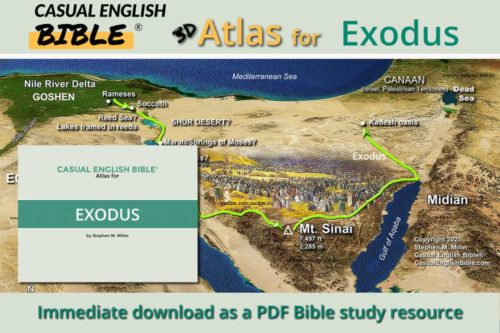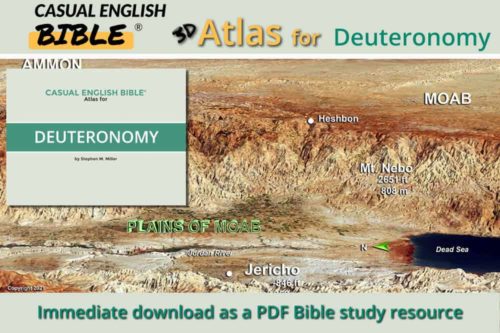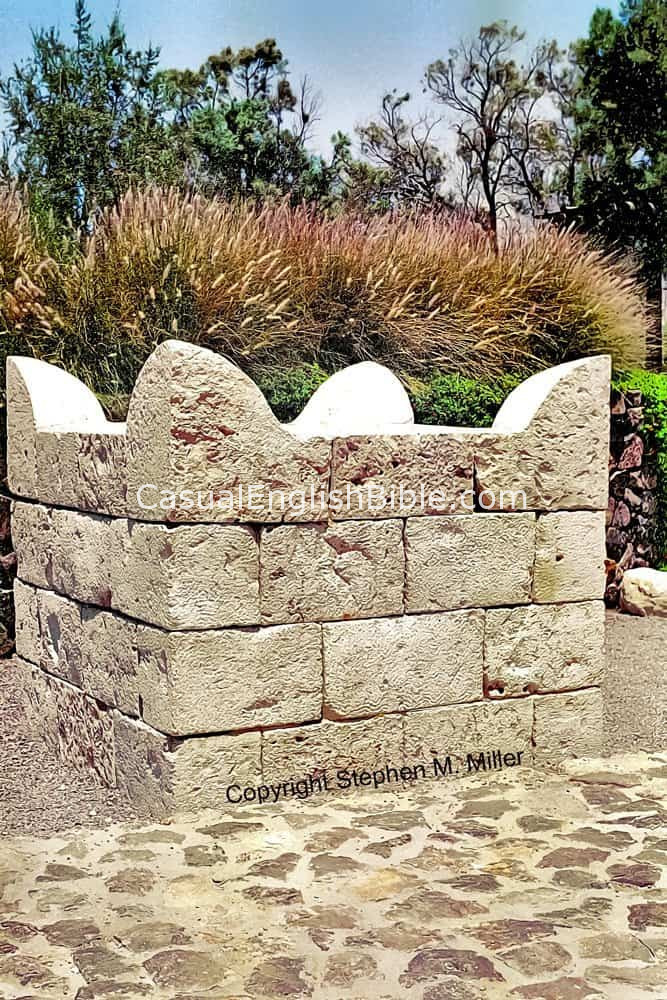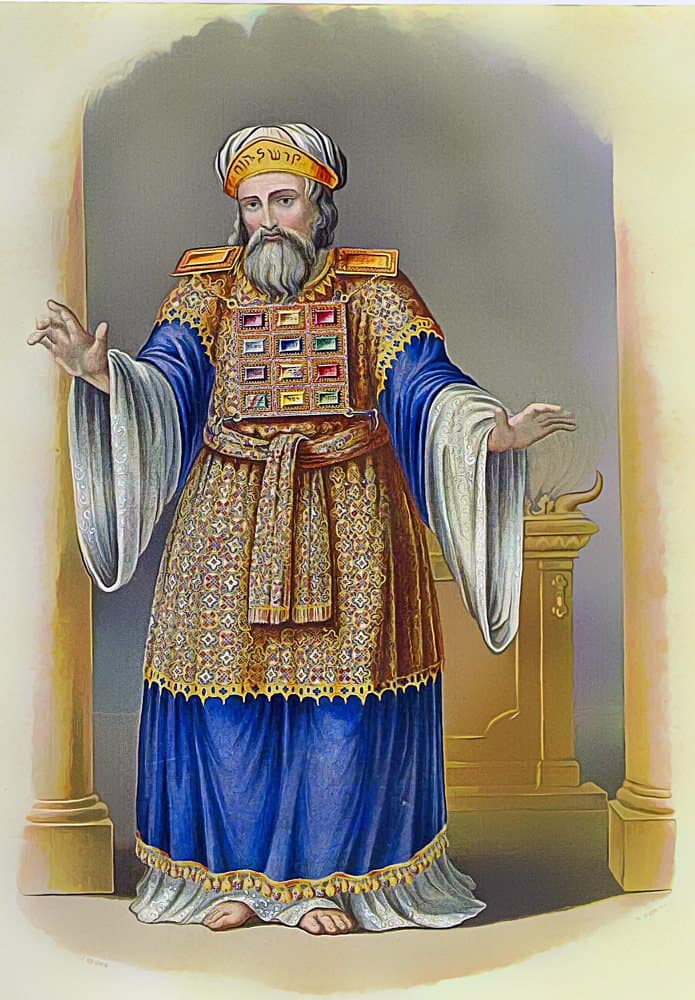Exodus 29
Ordaining Israel’s priests
Sacrifices on the menu
1Here’s what I want you to do to get Aaron and his sons ready to serve as priests. Select a young bull and two male sheep with no physical defects. 2Then, from the best wheat flour you can find, make bread, cakes, and wafers. But don’t use yeast in any of these. Instead, brush them with olive oil. 3Put these baked goods in a basket and bring them to the tent worship center along with the bull and the two rams. 4Take Aaron and his sons to the entrance of the worship center, and wash them with water there.5Take the clothes Aaron will be wearing and dress him in the tunic shirt, the robe, the apron, and the belt. 6Take the turban that has the sacred medallion on it and place it on Aaron’s head. 7Now take the olive oil that’s used for anointing and pour it on his head. Do this to anoint him to serve as the high priest.
Death of a bull and ram
8Now dress Aaron’s sons in their tunics. 9Put their hats on them, as well as their sash belts. When you’ve done this, they and their families will have the right to serve as priests. This right will be theirs for one generation after another. 10Now, bring the bull near to the entrance of the tent worship center. Have Aaron and his sons put their hands on the head of this bull. [1]11With the LORD watching, slaughter the bull where it stands, near the entrance of the tent worship center. 12Collect some of the bull’s blood and use your finger to paint it onto the horns [2] at the four corners of the altar. Pour the rest out on the ground at the base of the altar. 13Collect the fat that covers the bull’s intestines and internal organs. Also cut off the long lobe of the liver, and take out both kidneys with the fat on them. Burn all of this on the altar. 14Take the rest of the bull, with the hide and the excrement, and carry it outside the camp. Burn it there as an offering to pay the price [3] for sin.
15Now take one of the two rams and have Aaron and his sons put their hands on its head. 16Slaughter the ram and collect some of its blood. Splash the blood against the sides of the altar. 17Cut the animal apart, removing its internal organs, and cutting off its legs and its head. 18Burn the entire animal on the altar. It will serve as a burnt offering [4] for sin. The scent of a barbecued offering like this makes the LORD happy. [5]
Painting blood on ear and toes
19Now take the second ram and have Aaron and his sons put their hands on its head. 20Slaughter the ram. Collect some of its blood and paint it onto Aaron’s right earlobe. Do the same with his sons. Now paint some of the blood onto their right thumbs, their right hands, and the big toes of their right feet. [6] Splash some of the remaining blood around all four sides of the altar.21Now collect some of the blood on the altar and add it to some of the anointing oil. Sprinkle both of those onto Aaron and his clothing. Do the same to Aaron’s sons and their clothing. With this, Aaron and his sons and their clothing are devoted [7] to me, reserved for my use only.
Sacrifice of gratitude
22This is the sacrifice that authorizes [8] Aaron and his sons to serve as my priests. So cut the fat from the intestines and internal organs of the ram. Take it from the tail, as well. Cut off the long lobe from the liver. Take out both kidneys and the fat on them. Take the right thigh, too. 23Take out the baked goods made without yeast: one flat loaf of bread, one cake made with oil, and one wafer.24Pass these out to Aaron and his sons. Have them lift all of these into the air, as an offering of gratitude. [9] 25Then take them from Aaron and his sons and offer them as a burnt sacrifice, The scent of a barbecued offering like this makes the LORD happy. 26Next, take the breast of the ram used to authorize Aaron as a priest and lift it into the air. Then take this part of the animal for yourself. It is yours to keep. [10]
27Reserve for Aaron and his sons the rest of the breast along with the thigh of the ram used to authorize them to serve as priests. These parts of the ram in this kind of sacrifice will belong to them. 28So in the future when anyone offers a sacrifice of gratitude, this part of the sacrificial animal will belong to Aaron and his sons. So, this part of the contribution that people bring to the LORD to express their gratitude will belong to them now and always.
Dressing for ordination
29The sacred clothes made for Aaron will belong to his descendants who serve as priests in the generations to come. They will wear these clothes when they are anointed for ministry as priests. 30Whoever succeeds Aaron as high priest will wear these clothes whenever they walk into the tent worship center and then into the most Most Sacred Room. They should wear these clothes for seven days.First meal as a priest
31Now take the priests' share of the ram used to authorize Aaron and his sons to serve as priests, and boil it in a sacred place. 32Aaron and his sons are to eat the meat of this ram along with the bread that was placed in the basket at the entrance to the tent worship center.33They are allowed to eat part of the meat from the sacrifice used to authorize and dedicate them to serve as priests. But others are not allowed to eat it because these offerings are holy and are reserved for this sacred purpose. 34If on the next morning there are leftovers from the bread or the ram used authorize the ministry of Aaron and his sons, burn them. You're not allowed to eat them anymore. They belong to God. [11]
35Do everything I told you to do. Authorize Aaron and his sons to serve as priests. This authorization observance should continue for seven days. 36Every day during this week I want you to sacrifice a bull to purify them by atoning for any sin they committed and by getting rid of it. After the sacrifice, purify the altar by pouring olive oil on it. 37Every day for seven days I want you to purify the altar and dedicate it for service to God. When you do that, this will become a sacred place and whatever touches it will become holy.
Two sacrifices every day
38From now on, every day I want you to sacrifice a pair of one-year-old lambs. 39Sacrifice the first lamb in the morning and the second lamb at dusk. 40When you sacrifice the morning lamb, add two quarts [12] of your best flour mixed with one quart of your finest olive oil. Also offer a quart of wine as a liquid offering. 41Do the same thing with the evening lamb, offering the same mixture of flour and olive oil along with some wine. 42Continue offering these sacrifices every day throughout the generations. Present them to the LORD near the entrance into the tent worship center where I will meet you and talk with you. 43I will meet with the people of Israel here at this worship center. This will become a holy place because I am here. 44I will dedicate the altar as a sacred space. And I will dedicate Aaron and his sons as sacred men in the sacred ministry of serving me as priests. 45I will live here with the people of Israel. I will be their God. 46They're going to know that I'm their LORD and God. And they're going to remember I brought them out of Egypt, because I’m right here with them. I brought them out so I could live alongside them as their LORD and God.Footnotes
[1] 29:10. The bull was about to be sacrificed to atone for the sins of these men. Placing their hands on the bull may have been a symbolic way of saying their sins were being transferred to the bull and that God would accept the sacrifice of the bull instead of requiring them to die. See the footnote for 29:14.
Archaeologists have uncovered many “horned altars” in Israel and Palestinian Territories. Bible writers never explained why altars were built with the corners turned up like animal horns. Perhaps the horns were a tribute to the livestock sacrificed on the altar. One more common guess is that the horns gave priests something to which they could tie the dead animal. This could help keep the sacrificed animal from rolling off the fire before it was burned. Psalm 118:27 seems to add credibility to that theory: “Go ahead and tie the festival sacrifice to the four corners of the altar.” Consider how it might feel for a worshiper to watch the sacrificed animal roll off the flaming altar before the animal had even caught fire. We might understand that the animal fell off because the burning wood pile shifted as wood disintegrated in the fire. But someone offering a sacrifice to seek forgiveness for sin might think God had just rejected the offering.
More literally, “atone.” Jews taught that in God’s eyes, sin was a capital offense. Jewish law, however, says God allowed them to substitute the death of an animal for the death they deserved. “For the life of the body is in its blood. I have given you the blood on the altar to purify you, making you right with the Lord. It is the blood, given in exchange for a life, that makes purification possible” (Leviticus 17:11 New Living Translation). The writer of Hebrews says the blood of Jesus was the last sacrifice needed; it paid the price for the sins of all people for all time (Hebrews 10:10).
A “burnt offering” is one that consumes the entire animal and pays the price for sin, atoning for sin. Laws related to the burnt offering are in Leviticus 1.
Not that God loves barbecue, but that he loves it when people regret their sins and do their best to obey the laws he has given them.
There is no explanation for this ritual. But the blood of the sacrifice that authorizes them for ministry as priests is placed on them from head to toe, perhaps an indication that God authorizes them completely, and that they are reserved exclusively for God’s business.
More literally, “holy.”
More literally, ordains,” as in ordaining someone to serve as a minister.
This sacrificial offering goes by various names: fellowship offering, elevation offering, symbolic offering, special offering, and wave offering. The Hebrew word can mean to wave, lift, or blow. Whatever we call it, this sacrifice represented the culmination of an ordination service authorizing someone for ministry. It was the final act, which some scholars say was mainly an expression of gratitude to God for allowing these men to be assigned to lead the worship rituals for the people of Israel.
The priest officiating a sacrificial offering like this got to keep the breast and a leg of the animal. It was part of his salary. Moses kept part of the breast because he was still in the process of authorizing or ordaining Aaron for the priesthood. Aaron and his sons would get the rest of the breast and leg (29:27). They were to eat it (29:31-32).
Literally, “They are holy.”
Two dry quarts equals about 2.2 dry liters.
Discussion Questions
- Sorry, there are currently no questions for this chapter.








